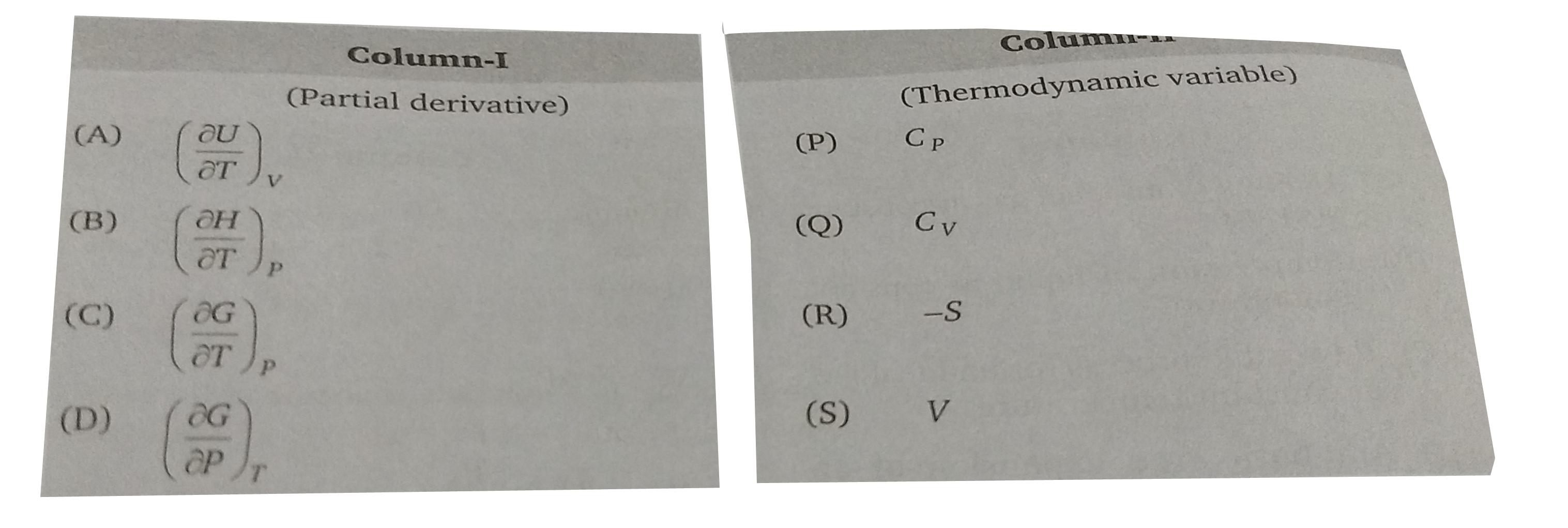What is the normal boiling point of mercury?
Given : ΔH∘f(Hg,l)=0,S∘(Hg,l)=77.4J/K−mol
ΔH∘f(Hg,g)=60.8kJ/mol,S∘(Hg,g)=174.4J/K−mol Solution in Punjabi
624.8 K
626.8 K
636.8 K
None of these
The correct Answer is:B
Hg⇔Hg(g),
ΔrS∘=174.4−77.4=97J/K−mol
∵ ΔG∘=ΔH∘−T.ΔS∘=0
T=ΔH∘ΔS∘
=60.8×100097=626.8K
Topper's Solved these Questions
- THERMODYNAMICSBOOK - NARENDRA AWASTHICHAPTER - THERMODYNAMICSEXERCISE - Level 3 - One Or More Answers Are Correct
1 Video
- THERMODYNAMICSBOOK - NARENDRA AWASTHICHAPTER - THERMODYNAMICSEXERCISE - Level 3 - Match The Column
2 Videos
- THERMODYNAMICSBOOK - NARENDRA AWASTHICHAPTER - THERMODYNAMICSEXERCISE - Level 2 (Q.1 To Q.30)
1 Video
- STOICHIOMETRYBOOK - NARENDRA AWASTHICHAPTER - STOICHIOMETRYEXERCISE - Level 3 - Subjective Problems
20 Videos
Similar Questions
Assume ideal gas behaviour for all the gases considered and neglect vibrational degrees of freedom. Separate equimolar sample. Separate equimolar samples of Ne, O2 , CO2 and SO2 were subjected to a two process as mentioned. Initially all are at same state of temperature and pressue.
Step I → All undergo reversible adiabatic expansion to attain same final volume, which is double the original volume thereby causing the decreases in their temperature.
Step → After step I all are given appropriate amount of heat isochorically to restore the original temperature.
Mark the correct option(s) :
View SolutionMatch the following columns

View SolutionWrite structure of 2,2-dimethylheptane.
View SolutionWhat volume of a liquid (in L) will contain 10 mole ? If molar mass of liquid is 280 and its density is 1.4 g/mL.
View SolutionDeltaH and DeltaS for Br_(2)(l) +CI_(2)(g) rarr 2BrCI(g) are 29.00 kJ mol^(-1) and 100.0 J K^(-1) mol^(-1) respectively. Above what temperature will this reaction become spontaneous?
View SolutionFor the reaction at 273K
NO(g)+O3(g)→NO2(g)+O2(g)
It is observed that the pressure of NO(g) falls form 700mmHg to 500mmHg in 250s. Calculate the average rate of reaction in (a) atms−1 , (b) molL−1s−1.
View SolutionWhat is the normal boiling point of mercury? Given : DeltaH _(f)^(@)(Hg,l)=0,S^(@)(Hg,l)=77.4 J//K-"mol" DeltaH _(f)^(@)(Hg,g)= 60.8 kJ//"mol", S^(@)(Hg, g)=174.4 J//K-"mol"
View SolutionCinnabar (HgS) is a prominent ore of mercury. How many grams of mercury are present in 225g of pure HgS? Molar mass of Hg and S are 200.6 g mol−1 and 32gmol−1 respectively.
View SolutionBased on data given below, match column-I and column II 3X(g)overset("250K,1atm")toX_3(g), DeltaH=-200 KJ//mol , DeltaS=-300 J//K//mol X(l)overset("1atm,250K")toX(g), DeltaH_(vap)=10 KJ//mol X_3(l)overset("500K,1atm")toX_3(g), DeltaH_(vap)=80 KJ//mol X_3 (g,250 K , 1 atm ) toX_3 (g, 500 K, 1 atm) DeltaH =100KJ/mol, DeltaS =100 J/K/mol , DeltaG =60 KJ/mol Normal boiling point of X=250 K normal boiling point of X_3 =500 K. Enthalpy change and entropy change of cooling X_3(l) to lower temperature is neglible.
View SolutionCalculate the mass of mercury which can be liberated from HgO at 25∘C by the treatment of excess HgO with 41.84 kJ of heat at
(a) constant pressure
(b) constant volume conditions
Given :ΔH∘f(HgO,s)=−90.8kJmol−1 & M (Hg) = 200.6gmol−1
View SolutionGiven: ΔfH∘(kJ/mol) S∘m(J/Kmol)
Cl4(l)−135A215ACl4(g)−103.0308.7:
What is the boiling point of carbon tetrachloride?
View SolutionCinnabar (HgS) is a prominent ore of mercury. How many grams of mercury are present in 225g of pure HgS? Molar mass of Hg and S are 200.6 g mol−1 and 32gmol−1 respectively.
View SolutionWhat is the normal boiling point of mercury?
Given : ΔH∘f(Hg,l)=0,S∘(Hg,l)=77.4J/K−mol
ΔH∘f(Hg,g)=60.8kJ/mol,S∘(Hg,g)=174.4J/K−mol
View Solutionसिनबार (HgS ) मर्करी का एक प्रमुख अयस्क है। 225g शुद्ध HgS में कितने ग्राम मर्करी के कण विद्यमान होते है? Hg और S के मोलर द्रव्यमान क्रमशः 200gmol−1 और 32gmol−1 है।
View SolutionCalculate DeltaE° for the reaction CaC2(S)+2H2O(l)→Ca(OH)2(s)+C2H2(g) if ΔH°f(CaC2=−62.0KJ/mol)ΔH°f(H2O)=−286.0KJ/mol ΔH°f{Ca(OH)2}=−986.0KJ/mol ΔH°f(C2H2)=+227.0KJ/mol
View SolutionCaIculate AStotal and state whether the reaction is spontaneous or non-spontaneous at 25^@C . HgS(s) + O_2(g) rarr Hg(I) + SO_2(g)DeltaH^@ = -238.6 kj, DeltaS^@ = + 36.7J K^(-1) .
View Solution
